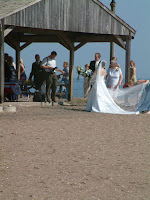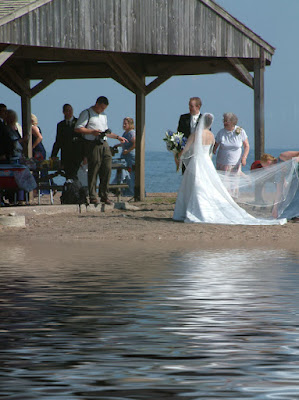
 Take a look at the two images in today's post. What happened to the water in the smaller shot? The left hand shot is very dramatic. The bride and groom standing on the edge of both the water and a new life together. Did the tide go out that far? Could it be that the shot was taken up on the Bay of Fundy, location of the world's highest tides. The time difference in that case could have been just a moment or two. (The tide does roll in or out that fast up there.) It would have been interesting to tell everyone at the wedding to freeze for a couple of minutes while the tide rises. The other alternative is that I was up to my neck in water and for some insane reason decided to make the shot less interesting by removing the water. There's another option and that's the subject of today's post.
Take a look at the two images in today's post. What happened to the water in the smaller shot? The left hand shot is very dramatic. The bride and groom standing on the edge of both the water and a new life together. Did the tide go out that far? Could it be that the shot was taken up on the Bay of Fundy, location of the world's highest tides. The time difference in that case could have been just a moment or two. (The tide does roll in or out that fast up there.) It would have been interesting to tell everyone at the wedding to freeze for a couple of minutes while the tide rises. The other alternative is that I was up to my neck in water and for some insane reason decided to make the shot less interesting by removing the water. There's another option and that's the subject of today's post..
The image on the left has been "doctored" using a plug-in. Plug-ins are add on pieces of the Photoshop puzzle. They're made to make life easier for the user. They're sort of like the Automatic or Program settings on the camera. You can wind up at the same spot using the camera in Aperture Priority or Shutter Priority or Manual modes, if the photographer has a good grasp of what the camera is doing or what adjusting the aperture does to the shutter speed. You might want to control the shutter speed by adjusting the aperture. If you have an idea how the camera works with light you, most likely, won't run your camera on Automatic or Program (there are cases where you might play with Program, but never (???) on Automatic). In the Automatic mode the camera makes all the decisions and the person at the controls in only there to adjust composition (and that only marginally). Plug-ins can't do anything that Photoshop doesn't allow. That doesn't mean plug-ins are bad.
.
Plug-ins, such as the one used on today's image, make life easier (or maybe "Automatic"). The plug-in used today is from a very clever company named "Flaming Pear". (name is a link) They make a variety of plug-ins to make different effects. This one is called "Flood". When you invoke the plug-in you're presented with a dialog box with several options. You can decide how high on the shot you want to apply your "shoreline". You have control over the shape and frequency of the "waves", the type of wave and the shading the wave has. The thing is, you can do all of this is Photoshop. You can copy and flip the image, apply a blur, use the "Distort" filter to produce a wave ripple and on and on. The trick is that you (one) have to know how to do all that and (two) have the time to go through a twenty or thirty step process to get where you want to go. Using a plug-ins can be like putting the camera on the Automatic mode and just punch buttons or it can be like using the Aperture Priority mode. In AP mode or in many plug-ins you are the decision maker. AP or the plug-in is there to do the heavy lifting. There a lot of mathematics being done by the camera in AP mode, just as there's some serious math being done within a plug-in.
.
Plug-ins are great devices for Photoshop users. They cut down the time a professional needs to spend to achieve an effect. They're worth every penny a working person spends if it speeds thier work flow. They're also a crutch for many who have no idea how their camera or Photoshop work. Just like kids today rely on computers or calculators to do math and have no idea how to make change when flipping burgers, an emphasis should be put on understanding what that time saving plug-in is doing before relying too heavily on them.





0 comments:
Post a Comment